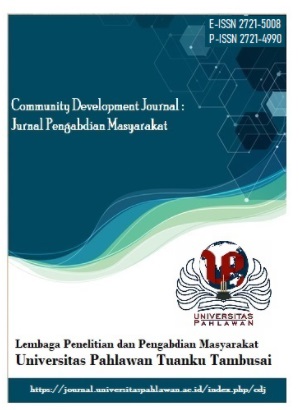ECONOMIC EMPOWERMENT OF SHELL CRAFTSMEN IN TELUK NIBUNG DISTRICT, TANJUNGBALAI CITY
DOI:
https://doi.org/10.31004/jrpp.v8i1.37642Keywords:
Economic Empowerment, Shell Craftsmen, Nibung Bay, MarketingAbstract
The economic empowerment of seashell craftsmen describes the lack of business capital to start, operate and develop a seashell craft business, lack of training and assistance for seashell craftsmen in improving their skills, lack of access to raw materials and equipment in producing seashell crafts, lack of marketing and promotion in empowerment shell craftsman. This research aims to find out the process of economic empowerment of seashell craftsmen in Teluk Nibung District, Tanjung Balai City, as well as the obstacles in the process of economic empowerment of seashell craftsmen. This research uses descriptive qualitative research methods. Data collection techniques used were observation, interviews and documentation. The data that researchers obtained was analyzed using several steps, namely data reduction, data presentation and drawing conclusions. The types of data used are primary data and secondary data. The results of this research show that the economic empowerment of seashell craftsmen carried out by the Social Service is an effort to overcome the problem of seashell crafts in Teluk Nibung District, Tanjung Balai City. The empowerment carried out by the Social Service through Dekranasda is quite good. The research results show that the economic empowerment of shell craftsmen in Teluk Nibung District can be improved through several strategies. First, increasing the skills and knowledge of craftsmen through training on more modern and efficient shell processing techniques. Second, developing a wider marketing network to expand market share. Third, providing access to business capital through collaboration with financial institutions and government programs. Apart from that, this research also found that support from the government and community is very important in supporting the sustainability of the shell craftsman business. The government's role in providing supportive facilities and policies, as well as active community participation in promoting local products, can have a positive impact on improving the economy of craftsmen. Thus, economic empowerment of shell craftsmen in Teluk Nibung District requires a holistic approach involving various parties, including the government, craftsmen and the community, to achieve better and more sustainable economic prosperity.References
Alsop, R., & Heinsohn, N. (2005). Measuring empowerment in practice: structuring analysis and framing indicators. Policy Research Working Paper No. 3510. Washington, DC: The World Bank.
Bakarbessy, D. (2021). Pemberdayaan Pengrajin Kulit Kerang Mutiara di Desa Batu Merah Kecamatan Sirimau Kota Ambon. Jurnal Badati Ilmu Sosial & Humaniora, 4(1), 67–68.
Bagong Suyanto & Emy Susanti Hendrarso. 1996. Wanita Dari Subordinasi dan Marginalisasi Menuju Ke Pemberdayaan. Surabaya: Airlangga University PressBoediono. 1993. Teori Pertumbuhan Ekonomi. Yogyakarta: BPFE
Bungin, Burhan. 2011. Metodologi Penelitian Kualitatif. Jakarta: Raja Wali Pers Com//2007/08/ Home Industri dan Mutualisme Dua Kegiatan Ekonomi Sebagai Langkah awal Untuk Menetaskan Kemiskinan, diakses 09 Januari 2017 pkl. 14.56 wib.
Jane C Ollenburger. Helen A moore. 1996. Sosiologi Wanita. Jakarta: PT Rineka Cipta
Creswell, J. W., & Creswell, J. D. (2017). Research Design: Qualitative, Quantitative, and Mixed Methods Approaches (5th ed.). Thousand Oaks, CA: SAGE Publications.
Duflo, E. (2012). Poor Economics: A Radical Rethinking of the Way to Fight Global Poverty. New York: PublicAffairs.
Kaplinsky, R. (2000). Globalisation and Unequalisation: What Can Be Learned from Value Chain Analysis?
Journal of Development Studies, 37(2), 117-146.
Kabeer, N. (2005). Gender equality and women’s empowerment: A critical analysis of the third millennium development goal. Gender & Development, 13(1), 13-24.
Mahendra, Y., Asfar, A. H., Ainulhaq, N., Pratiwi, I., Quraysin, I., Riyanto, A., Et Al. (2023). Pemanfaatan Limbah Cangkang Kerang Sebagai Alternatif Pembuatan Kerajinan Cinderamata Wisata Pantai Gope Kerangantu Banten. Jurnal Abdimas Ilmiah Citra Bakti , 4, 744-758.
Mardi Yatmo Hutomo. 2000. Pemberdayaan Masyarakat dalam Bidang Ekonomi. Yogyakarta: Adiyana Press Mubyarto. 2000. Membangun Sistem Ekonomi. Yogyakarta: BPFE
Keban, Y. T. (2004). Enam Dimensi Strategis Administrasi Publik: Konsep, Teori, dan Isu. Gava Media. Mahmudi. (2010). Manajemen Kinerja Sektor Publik. UPP STIM YKPN.
Meutia. (2017). Administration: Konsep, Makna, dan Implementasi dalam Organisasi.
Meadowcroft, J. (2009). Climate Policy and the Role of the State. In The Handbook of Global Climate and Environment Policy (pp. 295-313). Wiley-Blackwell.
Neill, J. (2022). Wawancara sebagai interaksi penelitian: Perspektif dan praktik.
Rachmasary, (2021). Penyusunan laporan keuangan usaha mikro kecil dan menengah berdasarkan standar akuntansi keuangan entitas mikro kecil dan menengah (Studi kasus UMKM Budi Lestari). Skripsi, Sekolah Tinggi Ilmu Ekonomi Indonesia.
Sen, A. (1999). Development as Freedom. New York: Alfred Knopf.
Suharto, E. (2010). Pekerjaan Sosial di Dunia Industri: Pengantar untuk Pemberdayaan Masyarakat.
Alfabeta.
Sugiyono. (2020). Metode Penelitian Kualitatif. Bandung: Alfabeta.
Sugiyono. (2022). Metode Penelitian Kualitatif. Alfabeta.
Wijana, M., Teknik, F., Mataram, U., & Guna, T. T. (2018). Berkelanjutan Untuk Menunjang Pariwisata Di Lombok – Ntb. 1, 386–390.
World Bank. (2013). Financial Inclusion and Development: The Role of Microfinance. Washington, DC: World Bank Publications.
Yusuf, A. (2008). Kerangka Konseptual dalam Penelitian. Jakarta: Penerbit XYZ.
Downloads
Published
How to Cite
Issue
Section
License
Copyright (c) 2025 Rosma Sopiani, Aiyub Aiyub, T. Alfiady, Ti Aisyah, Nazaruddin Nazaruddin

This work is licensed under a Creative Commons Attribution-ShareAlike 4.0 International License.






